WindyWindyWindy
Active member
Actually this links to the series drogue thread. It seems that your cleats are likely not good for 2000Kgs anyway.
Me, I'd rather be sitting in the pub.'Generations of seafarers'....... Many of whom are still sitting on the seabed due to inadequate technique or poor equipment.
Actually it's not a question but brain storming question..Tomaz,
Interesting question - which I'm not going to answer. Different yachts will have different cleat reinforcing.
Why did you ask the question?
Can you describe how or why your, single, cleat is taking all the tension of the rode.
Common advice for the rode would be to take the tension off the windlass to a strong point or strong points at the bow. However part of the same advice would be to use a snubber, or bridle (2 snubbers) which would minimise the snatch loads, the tension (it would be minimised by the elasticity of the snubber added to the snubbing effects of the catenary).
Using elasticity and catenary combined the snatch loads can be handled by hand.
If you have a single cleat as the ultimate fall back it would never come under stress if you have recommended snubbers and catenary.
Jonathan
Interestingly reports of cleats failing are uncommon, or at least not mentioned on YBW.
If you are using shackles with a breaking load of 1t or 2t then your yacht is quite small. The recommendation for a yacht of say, 35'-40' might be a 3/8th" shackle with a breaking load of 10t (the Working Load Limit might be 2t). But a heavier 35' yachts might use bigger shackles and lighter 40' yacht smaller shackles..... Maybe if you told us what yacht you have we might be better able to answer your question.Actually it's not a question but brain storming question..
I read a lot of threads regarding anchors, schackles, swivels, chain, rope, but nobody have concern about cleats which, on my opinion, might be weakest point.
I am using snubber, connected to the both of bow cleats..
And why would I pay attention on schackle breaking load (1 tone or 2 tones) if I know that cleat will be pulled out (with or without GRP piece) way ahead of that....
If you are using shackles with a breaking load of 1t or 2t then your yacht is quite small. The recommendation for a yacht of say, 35'-40' might be a 3/8th" shackle with a breaking load of 10t (the Working Load Limit might be 2t).
I'd comment that cleat failure is uncommon - I don't recall anyone reporting same over the last 20 years. Bow, amidship and stern cleats seem to be pretty bulletproof.
The 10t UTS for a 3/8th" shackle is on the basis, really crude, that the shackle fits the appropriately sized chain and hole in the anchor shank (bow through hole). Additionally this size would be typical for an anchor for a 35' - 40' yacht, say 15kg/20kg. The UTS of the recommended shackle, a G80 shackle, of 10t results in a WLL of 2t. However if the shackle is side loaded the WLL is reduced by 50% to 1,000kg. 1,000kg is near the WLL of the chain that is being used, 8mm G30 chain has a WLL of 750kg.'Small is beautiful'....
I'm thinking 'the recommendation' for shackles of Average Breaking Load 10t is rather OTT when the max load imparted through the anchor and gear is <500kg.
Perhaps 'the recommendation' is more related to over-selling than concern for underspecifying....
As for security of cleats, I've sailed on more than a couple of Brit-built boats with jibsheet cleats secured by nothing more than nuts - and that's just bare nuts!
I suspect that, if most JenBenBav/AWB smallcraft were lifted by their bow cleats, the keels - and likely the hulls, too - would fall off, leaving the deck dangling on high.

There speaks a True Believer!There will always be room and need for anchor threads
Actually, if you are blaming me, I do not devise Working Load Limits - these are devised by, the chain maker (who knows his galvanised chain is being used in an anchor rode) or a shackle maker (whose products have been largely replaced by other devices (like Omega Links) in the lifting industry. If you read the small; print for G30 galvanised chain it specifically says "Not to be used for Lifting". Specifically Omega links, lifting chain and other bits and pieces used in lifting are almost all universally sold to a 4:1 safety factor whereas (seldom used) shackles (often called 'anchor' shackles) are supplied with a 5:1 safety factor.There speaks a True Believer!
Since I'm in 'the mood' tonight, let's examine this WLL business. This concept derives from the LIFTING industry and its justifiable concern with proper working-practices' H&S, due to workers standing near and/or under the loads, and chain-lifting components being subjected to all imaginable forms of abuse.
I cannot quite see Jon Neeves, or myself, remotely likely to be at risk of an errant anchor falling on our heads.
I'm of the view that a chain or shackle's MinBreakLoad/MBL is of better relevance to us, and factor in a relevant margin.
Similarly, the LIFTING industry has formulated guidance - some of it mandatory - on what they specify as 'side loading'.... usually associated with chain or webbing lifting slings.
It is IMHO simplistic and not entirely helpful to adopt standards and practices from other industries and environments without a clear understanding of the context.
Harumph!
Somewhere in your above essay, you mention "snatch loads".The 10t UTS for a 3/8th" shackle is on the basis, really crude, that the shackle fits the appropriately sized chain and hole in the anchor shank (bow through hole). Additionally this size would be typical for an anchor for a 35' - 40' yacht, say 15kg/20kg. The UTS of the recommended shackle, a G80 shackle, of 10t results in a WLL of 2t. However if the shackle is side loaded the WLL is reduced by 50% to 1,000kg. 1,000kg is near the WLL of the chain that is being used, 8mm G30 chain has a WLL of 750kg.
So the G80 x 3/8th" shackle, the anchor size, the chain size are all around the WLL of 750kg/1,000kg and the yield strength of the chain, when it starts to deform, is 2 times WLL. Cheap shackles that you might see in the local hardware store would possibly have a UTS of 5t, WLL of 1,000kg - but the side loading would reduce the WLL to 500kg, well below that of the chain. G80 shackles cost peanuts, compared to the cost of the chain - more sensible to make the chain the weak link. You can buy Crosby G80 shackles from Tecni in the UK - there is no excuse to not buying one.
But a rated, 3/8th" G80 shackle is not over strength - its about right. Shackle are reported to fail, but not G80 shackles. Chain failure has not been mentioned on YBW for decades - chain strength, if bought to the recommended size by chain spread sheets, is equally strong. Since the introduction of the new rash of anchors Rocna, Spade etc etc reports of anchors dragging have disappeared as relics of history (and by and large - the demand that people oversize their anchor has been debunked). Reports of cleat failure are still as rare as dragon's teeth. The market place has learnt and swivel failure is also a thing of the past.
Snubbers do fail, with the sound much like gunshot (so you should carry a spare). But your rode should have back up securement, commonly some sort of chain lock using the bow roller to ensure the snatch loads are not instantly transferred to the windlass. The bow of a yacht is possibly one of the strongest parts of yacht construction - use that extra strength to your advantage (and if you have a flimsy bow - beef it up with some reinforcing).
If your snubber is excessively thin, or too short (ideal would be deck length) and have no elasticity - it will fail quickly. But a correctly sized and installed snubber tames snatch loads and it is well worth doing it correctly.
Basically all the tools, the data, the practices for anchoring and the choice of anchor is all available on YBW. Most people appear to follow the recommendations but there is still healthy debate - when recommendations are reiterated and new ideas aired. Most members on YBW saw the light, years ago, hence the absence of reports of failure - but we have new members who appear to be subjected to dated mantra - who still need to see the light.
There will always be room and need for anchor threads
Jonathan
Zoidberg is correct - a shackle with a 2t WLL is ridiculous for a 35' modern AWB. But every reputable shackle maker, Crosby, Campbell, Peerless, Yoke etc etc all, without exception, clearly point out on their websites that the WLL is degraded by 50% if the shackle is side loaded. Its the owner's decision but a G80 shackle is so easy to buy there is no reason to ignore the advise and recommendations. For those who have downsized their chain - from, say, 8mm to 6mm by using HT chain - the 3/8th" shackle will not fit the chain - use an Omega link as an enlarged link - and you are good to go and sacrifice no strength at all.
My rode is not subject to snatch loads as I use 2 snubbers (aka a bridle). I notice that other yachts, who do not use a snubber or one that is insufficiently elastic, thin or longer, can suffer snatch loads. This is not necessarily their fault - tight anchorages are often beset by bullets of wind that are funnelled down valleys or gaps in the trees. In calmer times these are balmy wind variations - in a storm and with limited space and inadequate snubbers - they can result in snatch loads. Because we commence our snubbers at the transom and had a 22' beam - we had long snubbers - well capable of managing snatch loads. Sadly not everyone reads my long posts on snubbers, in fact many are not even members, their loss - but the message is getting through.Somewhere in your above essay, you mention "snatch loads".
Was your rode subjected to snatch loads? Mine isn't.
Were you anchoring in very shallow water, subject to wave action?
Was your gear so light that it has no useful catenary?
Did your boat have disproportionate windage compared to its underwater shape?
Even when anchored in severe gale force winds, when there is a considerable load on my rode, it is not subjected to snatch loads (in the generally accepted meaning of the term).
With bad weather expected, I normally choose anchorages with a reasonable depth of water, meaning that my chain gives a useful catenary. I don't anchor where the boat will experience significant waves, but unlike you I am seldom able to avoid the full strength of the wind. I try not to be anchored under high ground in strong winds, as it tends to be very squally, both in strength and direction.
Anchored in strong winds, I will often rig a riding sail, to cut down on yawing, with its resultant heeling. I don't like spilling my soup.
Earnest searching after truth.
Huh! You're no fun!Are you willing to justify and support replacement of 8mm chain with 6mm chain, and 8mm as replacement for 10mm chain ...... as that might be the inevitable development from your.....Harumphing..
What is the difference between an omega link and a shackle ?
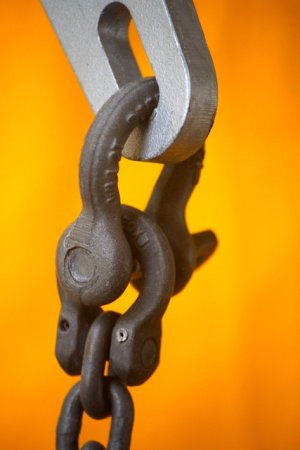
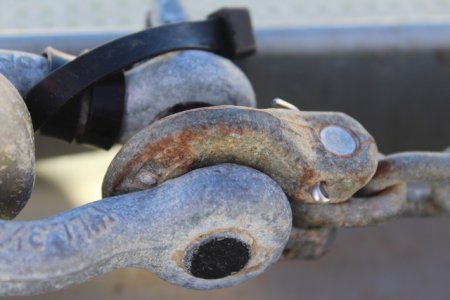
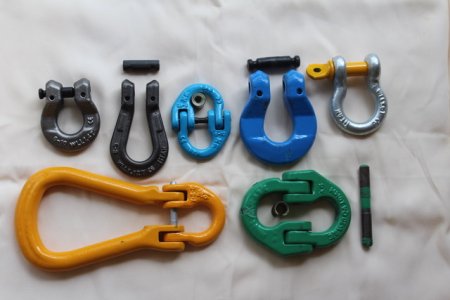
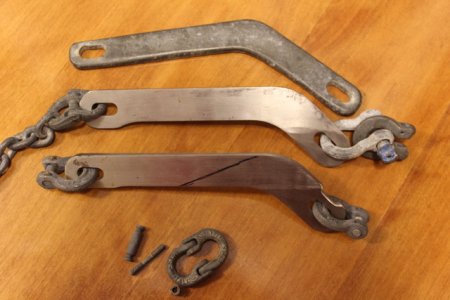
But surely it's better to avoid snatch loads in the first place, rather than rigging gear to mitigate their effect?My rode is not subject to snatch loads as I use 2 snubbers (aka a bridle). I notice that other yachts, who do not use a snubber or one that is insufficiently elastic, thin or longer, can suffer snatch loads. This is not necessarily their fault - tight anchorages are often beset by bullets of wind that are funnelled down valleys or gaps in the trees. In calmer times these are balmy wind variations - in a storm and with limited space and inadequate snubbers - they can result in snatch loads. Because we commence our snubbers at the transom and had a 22' beam - we had long snubbers - well capable of managing snatch loads. Sadly not everyone reads my long posts on snubbers, in fact many are not even members, their loss - but the message is getting through.
Jonathan
But surely it's better to avoid snatch loads in the first place, rather than rigging gear to mitigate their effect?
You rig gear, its called lots of heavy chain, I had a modern catamaran and I wanted to keep it light so that I could sail fast. Lots of heavy chain costs money and weighs a lot. My rode was as light as you can get, 6mm chain for a yacht with the windage of a Bav 45, I replaced old fashioned catenary with 20th century elasticity, your catenary and my elasticity do exactly the same thing - absorb snatch loads, so you and I don't even know they were snatch loads. My snubbers are much more effective at absorbing snatch loads than your chain - I don't need to deploy as much rode as you do, for the same effect. My chain takes up little room as well as being lighter than your chain.But surely it's better to avoid snatch loads in the first place, rather than rigging gear to mitigate their effect?

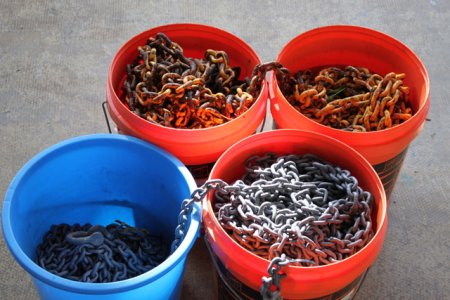
Get yourself some retired climbing rope add your Aliexpress Low Friction Rings, a pair of gloves, pack in neat canvas bag marked 'snowflake recovery kit' and you have an almost perfect snow vehicle recover kit (to which you alude in your post) - winter is coming - all you need are some snowflakes, preferably fresh.Huh! You're no fun!
I DID upcycle to shiny new 6mm high-test Gunnebo chain, accepting last year's argument. That was as much 'retail therapy' as religious fervour, but WTH.
There's still a pile of G30 x 8mm in good nick gathering dust in my polytunnel, waiting perhaps for me to acquire 'nothr project' that needs it.... oh, and a clutch of cheap-as-chips BigSodOff Low Friction Rings c/w big fat Softee Shackles, courtesy of AliExpress ( rated at a fabulous 45,000lbf ) that are looking for work.
Perhaps I should put together some Off-Road Recovery kits, against the unlikely event of me sliding into an Ozzie donga in a huge all-wheel drive truck.
Time for coffee....!